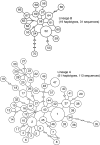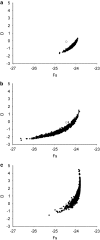Mitochondrial DNA variation in the malaria vector Anopheles minimus across China, Thailand and Vietnam: evolutionary hypothesis, population structure and population history
- PMID: 20517346
- PMCID: PMC3183880
- DOI: 10.1038/hdy.2010.58
Mitochondrial DNA variation in the malaria vector Anopheles minimus across China, Thailand and Vietnam: evolutionary hypothesis, population structure and population history
Abstract
The effects of Pleistocene environmental fluctuations on the distribution and diversity of organisms in Southeast Asia are much less well known than in Europe and North America. In these regions, the combination of palaeoenvironmental reconstruction and inferences about population history from genetic data has been very powerful. In Southeast Asia, mosquitoes are good candidates for the genetic approach, with the added benefit that understanding the relative contributions of historical and current processes to population structure can inform management of vector species. Genetic variation among populations of Anopheles minimus was examined using 144 mtDNA COII sequences from 23 sites in China, Thailand and Vietnam. Haplotype diversity was high, with two distinct lineages that have a sequence divergence of over 2% and exhibit different geographical distributions. We compare alternative hypotheses concerning the origin of this pattern. The observed data deviate from the expectations based on a single-panmictic population with or without growth, or a stable but spatially structured population. However, they can be readily accommodated by a model of past fragmentation into eastern and western refugia, followed by growth and range expansion. This is consistent with the palaeoenvironmental reconstructions currently available for the region.
Figures




Similar articles
-
Population genetics of the malaria vector Anopheles aconitus in China and Southeast Asia.Infect Genet Evol. 2012 Dec;12(8):1958-67. doi: 10.1016/j.meegid.2012.08.007. Epub 2012 Sep 12. Infect Genet Evol. 2012. PMID: 22982161 Free PMC article.
-
Population structure and population history of Anopheles dirus mosquitoes in Southeast Asia.Mol Biol Evol. 2000 Jun;17(6):962-74. doi: 10.1093/oxfordjournals.molbev.a026377. Mol Biol Evol. 2000. PMID: 10833203
-
Population genetic structure of the malaria vector Anopheles minimus in Thailand based on mitochondrial DNA markers.Parasit Vectors. 2021 Sep 26;14(1):496. doi: 10.1186/s13071-021-04998-7. Parasit Vectors. 2021. PMID: 34565456 Free PMC article.
-
Genetic population structure of the malaria vector Anopheles baimaii in north-east India using mitochondrial DNA.Malar J. 2012 Mar 20;11:76. doi: 10.1186/1475-2875-11-76. Malar J. 2012. PMID: 22429500 Free PMC article.
-
Multilocus nuclear DNA markers reveal population structure and demography of Anopheles minimus.Mol Ecol. 2014 Nov;23(22):5599-618. doi: 10.1111/mec.12943. Epub 2014 Oct 30. Mol Ecol. 2014. PMID: 25266341
Cited by
-
Population genetics of the malaria vector Anopheles aconitus in China and Southeast Asia.Infect Genet Evol. 2012 Dec;12(8):1958-67. doi: 10.1016/j.meegid.2012.08.007. Epub 2012 Sep 12. Infect Genet Evol. 2012. PMID: 22982161 Free PMC article.
-
Genetic homogeneity of Anopheles maculatus in Indonesia and origin of a novel species present in Central Java.Parasit Vectors. 2019 Jul 15;12(1):351. doi: 10.1186/s13071-019-3598-1. Parasit Vectors. 2019. PMID: 31307517 Free PMC article.
-
Molecular phylogeny of Anopheles nivipes based on mtDNA-COII and mosquito diversity in Cambodia-Laos border.Malar J. 2022 Mar 17;21(1):91. doi: 10.1186/s12936-022-04121-w. Malar J. 2022. PMID: 35300704 Free PMC article.
-
The polymorphism and the geographical distribution of the knockdown resistance (kdr) of Anopheles sinensis in the Republic of Korea.Malar J. 2012 May 3;11:151. doi: 10.1186/1475-2875-11-151. Malar J. 2012. PMID: 22554130 Free PMC article.
-
Mitochondrial variation in subpopulations of Anopheles balabacensis Baisas in Sabah, Malaysia (Diptera: Culicidae).PLoS One. 2018 Aug 23;13(8):e0202905. doi: 10.1371/journal.pone.0202905. eCollection 2018. PLoS One. 2018. PMID: 30138386 Free PMC article.
References
-
- Avise JC. Phylogeography: the History and Formation of Species. Harvard University Press: Cambridge, MA; 2000.
-
- Ballard JWO, Whitlock MC. The incomplete natural history of mitochondria. Mol Ecol. 2004;13:729–744. - PubMed
-
- Beebe NW, Ellis JT, Cooper RD, Saul A. Nucleotide DNA sequence analysis of the ribosomal DNA ITS2 region for the Anophelespunctulatus group of mosquitoes. Insect Mol Biol. 1999;8:381–390. - PubMed
-
- Brandon-Jones D. The Asian Colobinae (Mammalia: Cercopithecidae) as indicators of Quaternary climatic change. Biol J Linn Soc. 1996;59:327–350.
-
- Cannon CH, Manos PS. Phylogeography of the Southeast Asian stone oaks (Lithocarpus) J Biogeog. 2003;30:211–226.
Publication types
MeSH terms
Substances
Grants and funding
LinkOut - more resources
Full Text Sources
Miscellaneous

